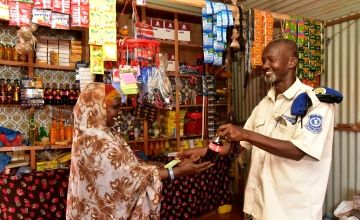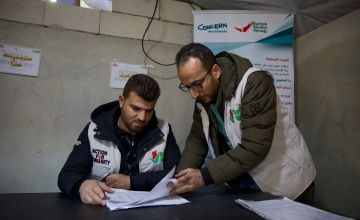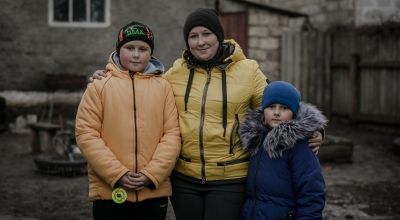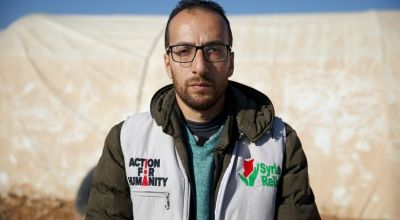
Knowledge Hub
Extreme poverty is a term established by the World Bank to refer to a person living on less than $2.15 USD (£1.73 GBP) and is an estimate of what a person needs to afford basic amenities, including food and water.
A combination of the after-effects of Covid-19, as well as the cost-of-living crisis, has led extreme poverty to rise for the first time in two decades. According to the World Bank, growing evidence suggests that financial inclusion interventions can “provide a valuable pathway out of extreme poverty.”
Part of Concern Worldwide’s strategy to eliminate extreme poverty includes utilising financial inclusion methods as a means to drive development within communities, enabling the people we work with to have the freedom to take control of their lives.
Here’s how financial inclusion works as a tool to eliminate extreme poverty.
What is financial inclusion?
Financial inclusion is the process of enabling accessibility to financial services within a community, fostering an environment where people can adapt to changing circumstances in the economy and take advantage of financial opportunities. Globally, limitations on financial inclusion remain a significant obstacle for many communities, with 1.7 billion adults being unbanked, lacking accounts at a financial institution or through mobile money providers. Low levels of financial inclusion primarily stem from an absence of financial institutions in particular regions, lack of trust for those institutions as well as high entry requirements to open accounts.
Keep reading to find out how we’re improving financial inclusion in vulnerable communities.
What is financial literacy?
One of the cornerstones of economic empowerment is financial literacy. Financial literacy leads to the development of skills and behaviour that drive informed decisions concerning money, employment rights, investments and the ownership of assets.
Even within high-income countries, such as the UK, financial education can help alleviate stresses caused by the cost of living on households. In fact, according to the Financial Times, 44% of British adults believe they would be ‘in much better shape financially’ if they had been taught basic money management skills such as budgeting. For communities living in extreme poverty, financial literacy is also an important tool in strengthening finances within the household.

How can financial literacy help those living in extreme poverty?
Financial illiteracy is a huge issue affecting people living in low-income countries and communities that compounds already existing systemic poverty. According to the Standard & Poor’s Rating Services Global Financial Literacy Survey, the world’s largest global measurement of financial literacy, only 33% of adults worldwide are financially literate, with higher levels of illiteracy found in low income countries in Asia and Africa. A lack of knowledge about finance and financial products acts as an obstacle to people accessing banking and financial services, which forms barriers to financial markets.
Educating communities on financial issues can have longstanding benefits, including improving income and savings, but it also enables better access to essential financial goods and services. This has the added benefit of reducing poverty and economic vulnerability, leading to increased economic growth in the community, as well as better health and education outcomes.

Modernising financial aid
Digital technology for cash transfers has become an important method in how we respond to humanitarian crises.
In terms of its relation to financial inclusion, cash transfers are a very effective form of humanitarian aid. In a humanitarian crisis, it can take weeks or even months to transport supplies into hard-to-reach areas. By contrast, once a cash distribution system has been put in place, vital funds can instantly reach thousands of people, regardless of their location. They allow people to purchase the goods or services that they most need which in turn supports the local economy as they buy from local markets, which engages local farmers, businesses and workers within the affected communities.
Mobile cash transfers have made this method even more efficient, with people able to access money through their phones within seconds. This is particularly effective in low-income countries where traditional banks may not be accessible.
Non-governmental organisations are making use of mobile financial services to provide access to savings, loans and other financial products to people who would otherwise lack access.

Loans to vulnerable communities
Part of Concern’s work includes driving microfinance initiatives in order to beat extreme poverty. Village Savings and Loans Associations (VSLAs) are an important tool in financial empowerment, keeping economic power locally and communally based.
VSLAs are defined as small, member run microfinancing groups, enabling those living in poverty to build savings and take out loans at low-interest rates. More than 70% of VSLA members are female – as VSLAs are valuable in providing women in low-income countries access and ownership over income, savings and decision-making power in the home. When women are financially empowered, economies grow.
Community Based Savings Groups
Another way of driving better financial outcomes and bridging the gap towards formal financial inclusion is through Community Based Savings Groups (CBSGs). CBSGs are groups of people living in a community that join to save money periodically, with the money being saved used to provide small loans to the members.
CBSGs have defined membership rules that outline the savings amounts, frequency of payment, and repayment terms. Alongside our VSLAs, scaling up support to CBSGs as an entry point for financial inclusion is one of the key approaches Concern is committed to under its Livelihood Strategy 2021-2025. CBSGs are another tool in our arsenal of driving economic self-determination for the communities we work with.
How Concern is improving financial education
In addition to our VSLA and CBSG work in driving better financial outcomes in low income communities, here at Concern Worldwide we consider education, of all kinds, to be at the heart of development and a key to breaking the poverty cycle.
In 2022, our education programmes reached 676,000 people.
- In 2022, our education programmes directly benefited over 131,000 people
- More than 545,000 benefited indirectly from our programmes.
- In one programme in Somalia, 20,300 children had access to free education.
Many of our education initiatives focus on the inclusion and development of many poor and marginalised segments of society – including boosting financial outcomes for women living in extreme poverty. Take a closer look at Concern’s education programmes.





